Leadership in Business: Entrepreneurship Characteristics and Success
VerifiedAdded on 2019/10/01
|19
|3907
|317
Report
AI Summary
This report investigates the impact of entrepreneurship characteristics on business success, mediated by risk-taking behavior in Malaysia. It begins with an introduction outlining the research aim, objectives, and questions, followed by a comprehensive literature review covering key concepts such as entrepreneurship characteristics, business success, and risk-taking behavior. The review critically examines relevant entrepreneurship models like the Enabler and Producer theories, along with supporting empirical studies and identifies the existing literature gap. The report then presents a conceptual framework and details the methodology, including the research paradigm (positivism), design (explanatory research), data collection methods, instrument, target population, sample size, and ethical considerations. A Gantt chart is included to visualize the project timeline, and the report concludes with a list of references. The study aims to analyze the relationship between entrepreneurship characteristics, risk-taking behavior, and business success, addressing four specific hypotheses within the Malaysian context.
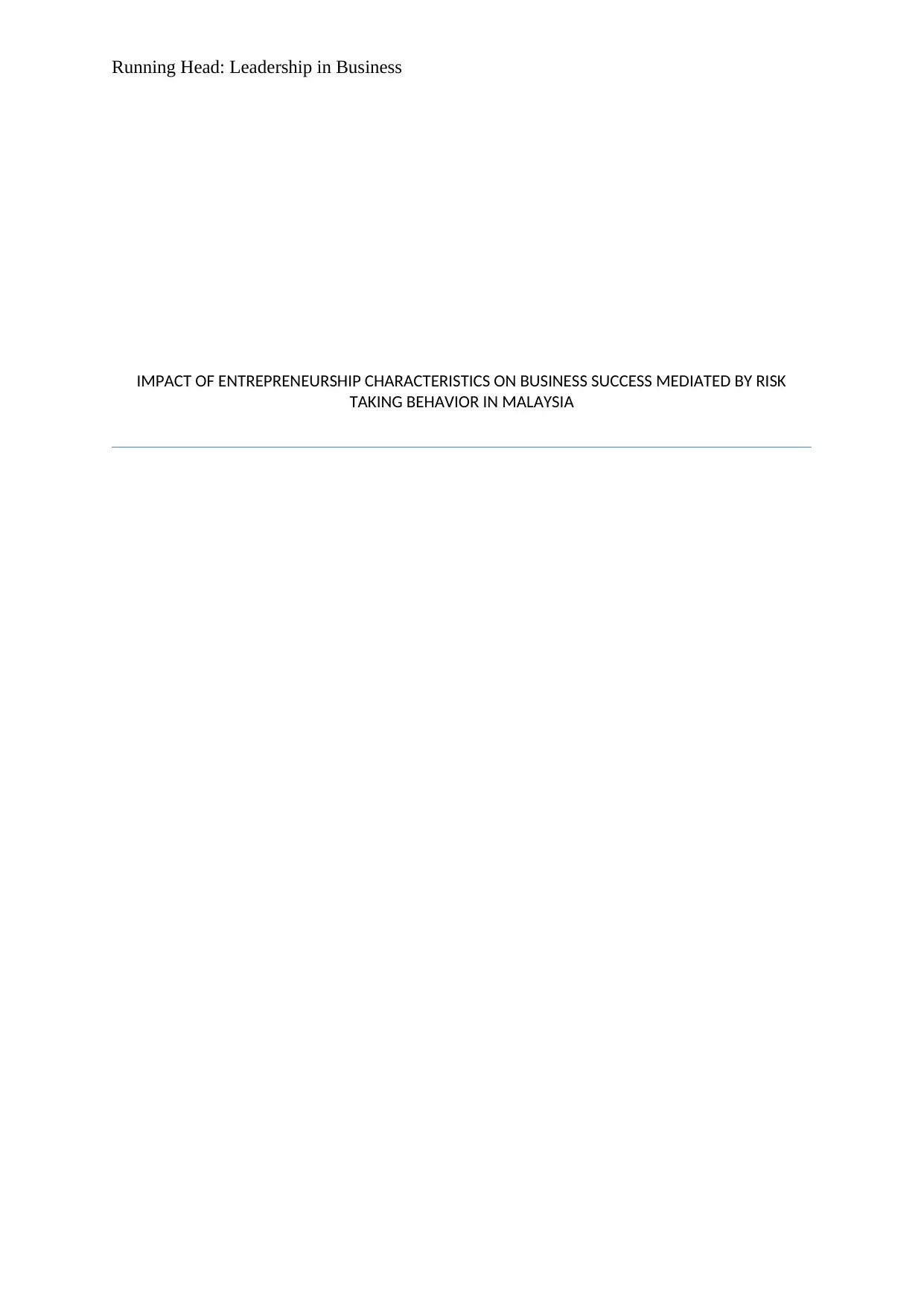
Running Head: Leadership in Business
IMPACT OF ENTREPRENEURSHIP CHARACTERISTICS ON BUSINESS SUCCESS MEDIATED BY RISK
TAKING BEHAVIOR IN MALAYSIA
IMPACT OF ENTREPRENEURSHIP CHARACTERISTICS ON BUSINESS SUCCESS MEDIATED BY RISK
TAKING BEHAVIOR IN MALAYSIA
Paraphrase This Document
Need a fresh take? Get an instant paraphrase of this document with our AI Paraphraser
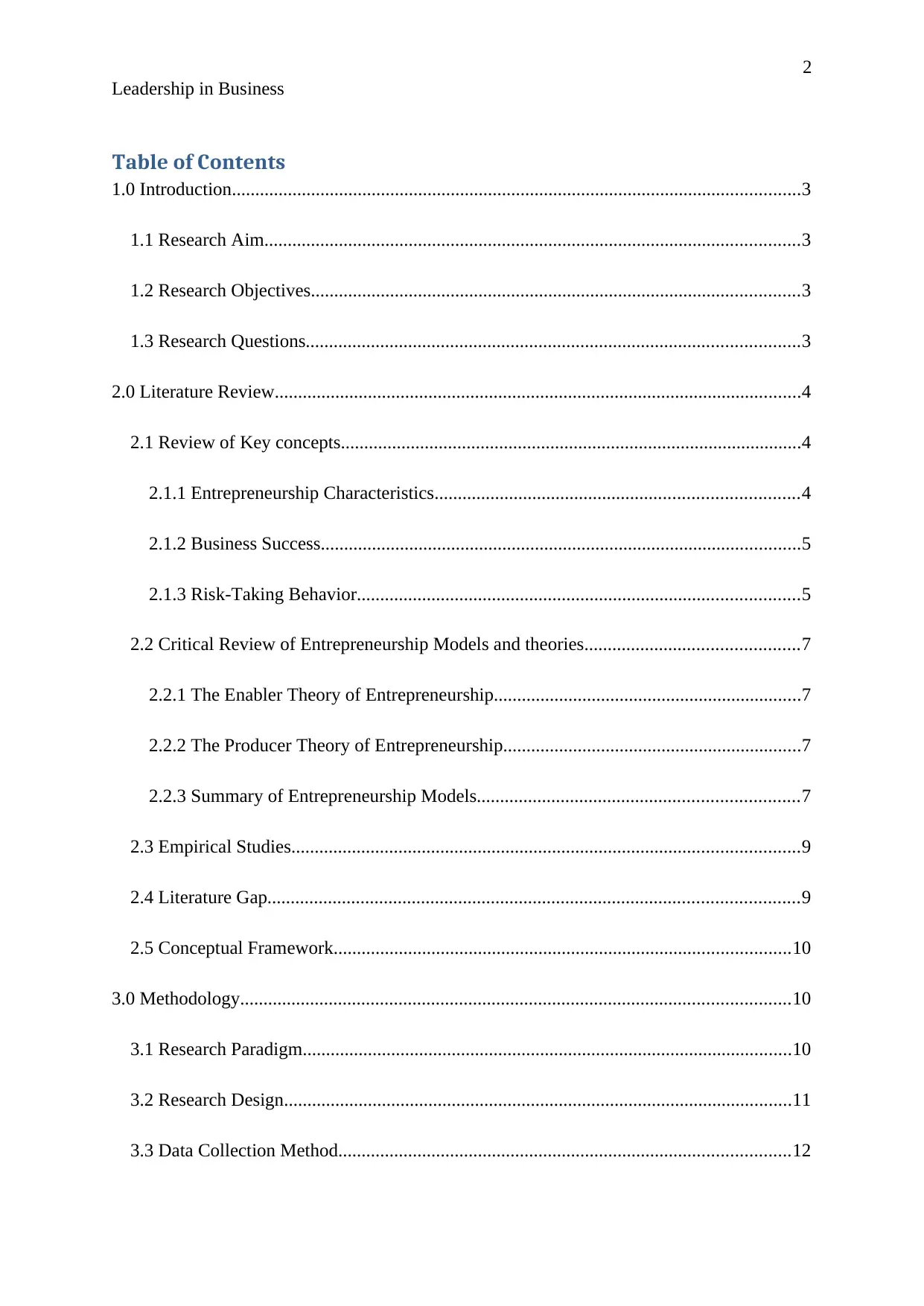
2
Leadership in Business
Table of Contents
1.0 Introduction..........................................................................................................................3
1.1 Research Aim...................................................................................................................3
1.2 Research Objectives.........................................................................................................3
1.3 Research Questions..........................................................................................................3
2.0 Literature Review.................................................................................................................4
2.1 Review of Key concepts...................................................................................................4
2.1.1 Entrepreneurship Characteristics..............................................................................4
2.1.2 Business Success.......................................................................................................5
2.1.3 Risk-Taking Behavior...............................................................................................5
2.2 Critical Review of Entrepreneurship Models and theories..............................................7
2.2.1 The Enabler Theory of Entrepreneurship..................................................................7
2.2.2 The Producer Theory of Entrepreneurship................................................................7
2.2.3 Summary of Entrepreneurship Models.....................................................................7
2.3 Empirical Studies.............................................................................................................9
2.4 Literature Gap..................................................................................................................9
2.5 Conceptual Framework..................................................................................................10
3.0 Methodology......................................................................................................................10
3.1 Research Paradigm.........................................................................................................10
3.2 Research Design.............................................................................................................11
3.3 Data Collection Method.................................................................................................12
Leadership in Business
Table of Contents
1.0 Introduction..........................................................................................................................3
1.1 Research Aim...................................................................................................................3
1.2 Research Objectives.........................................................................................................3
1.3 Research Questions..........................................................................................................3
2.0 Literature Review.................................................................................................................4
2.1 Review of Key concepts...................................................................................................4
2.1.1 Entrepreneurship Characteristics..............................................................................4
2.1.2 Business Success.......................................................................................................5
2.1.3 Risk-Taking Behavior...............................................................................................5
2.2 Critical Review of Entrepreneurship Models and theories..............................................7
2.2.1 The Enabler Theory of Entrepreneurship..................................................................7
2.2.2 The Producer Theory of Entrepreneurship................................................................7
2.2.3 Summary of Entrepreneurship Models.....................................................................7
2.3 Empirical Studies.............................................................................................................9
2.4 Literature Gap..................................................................................................................9
2.5 Conceptual Framework..................................................................................................10
3.0 Methodology......................................................................................................................10
3.1 Research Paradigm.........................................................................................................10
3.2 Research Design.............................................................................................................11
3.3 Data Collection Method.................................................................................................12
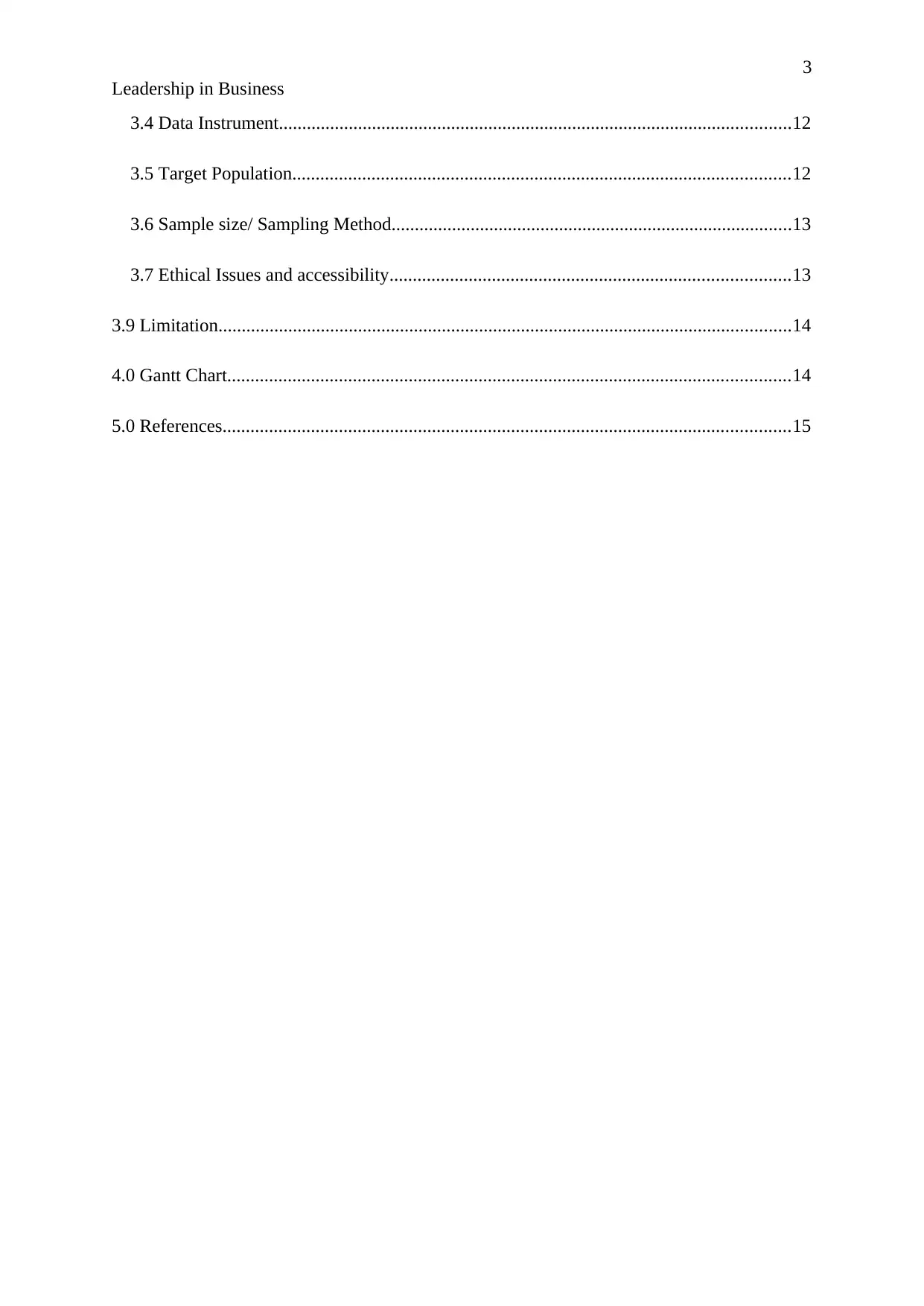
3
Leadership in Business
3.4 Data Instrument..............................................................................................................12
3.5 Target Population...........................................................................................................12
3.6 Sample size/ Sampling Method......................................................................................13
3.7 Ethical Issues and accessibility......................................................................................13
3.9 Limitation...........................................................................................................................14
4.0 Gantt Chart.........................................................................................................................14
5.0 References..........................................................................................................................15
Leadership in Business
3.4 Data Instrument..............................................................................................................12
3.5 Target Population...........................................................................................................12
3.6 Sample size/ Sampling Method......................................................................................13
3.7 Ethical Issues and accessibility......................................................................................13
3.9 Limitation...........................................................................................................................14
4.0 Gantt Chart.........................................................................................................................14
5.0 References..........................................................................................................................15
⊘ This is a preview!⊘
Do you want full access?
Subscribe today to unlock all pages.

Trusted by 1+ million students worldwide
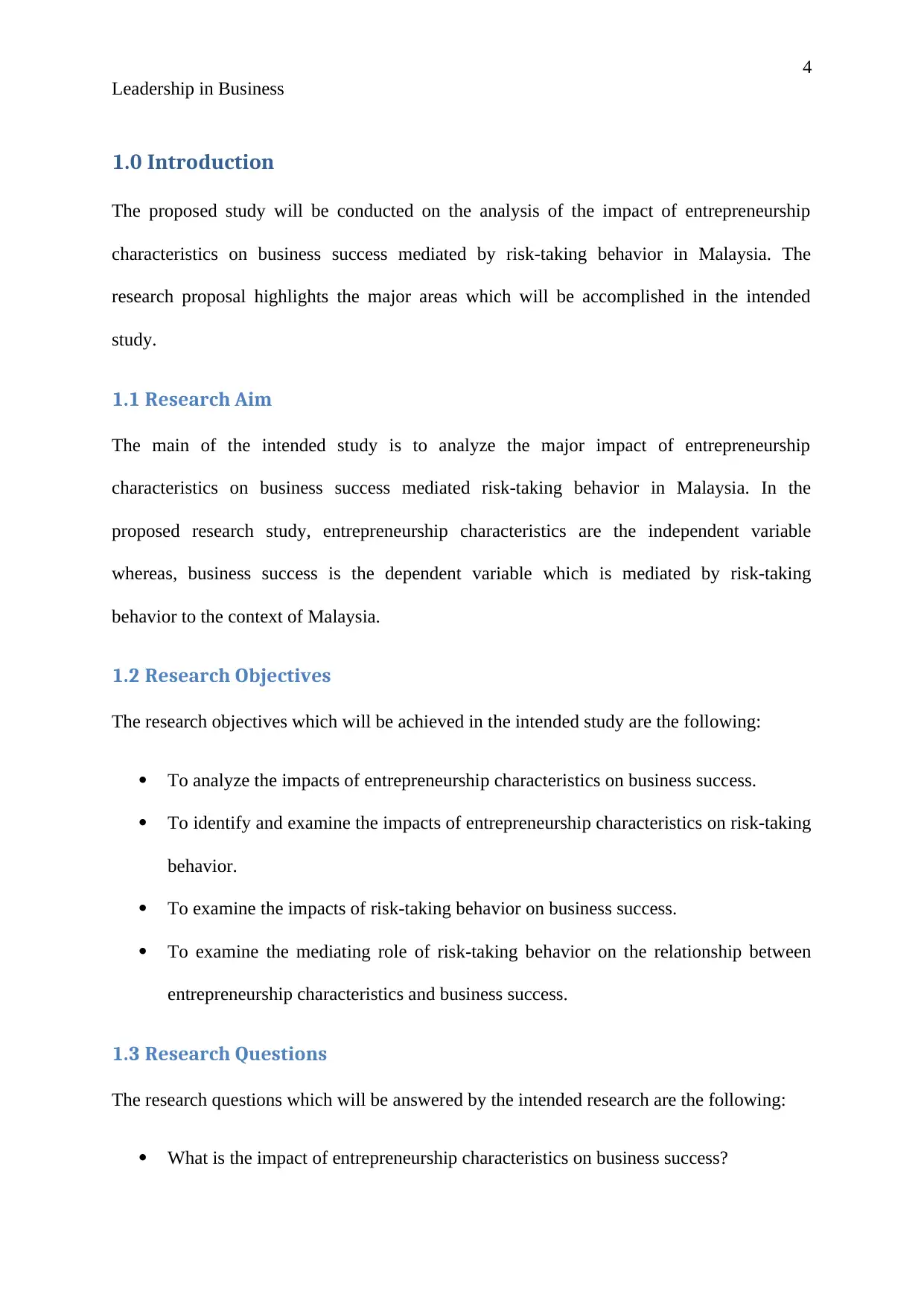
4
Leadership in Business
1.0 Introduction
The proposed study will be conducted on the analysis of the impact of entrepreneurship
characteristics on business success mediated by risk-taking behavior in Malaysia. The
research proposal highlights the major areas which will be accomplished in the intended
study.
1.1 Research Aim
The main of the intended study is to analyze the major impact of entrepreneurship
characteristics on business success mediated risk-taking behavior in Malaysia. In the
proposed research study, entrepreneurship characteristics are the independent variable
whereas, business success is the dependent variable which is mediated by risk-taking
behavior to the context of Malaysia.
1.2 Research Objectives
The research objectives which will be achieved in the intended study are the following:
To analyze the impacts of entrepreneurship characteristics on business success.
To identify and examine the impacts of entrepreneurship characteristics on risk-taking
behavior.
To examine the impacts of risk-taking behavior on business success.
To examine the mediating role of risk-taking behavior on the relationship between
entrepreneurship characteristics and business success.
1.3 Research Questions
The research questions which will be answered by the intended research are the following:
What is the impact of entrepreneurship characteristics on business success?
Leadership in Business
1.0 Introduction
The proposed study will be conducted on the analysis of the impact of entrepreneurship
characteristics on business success mediated by risk-taking behavior in Malaysia. The
research proposal highlights the major areas which will be accomplished in the intended
study.
1.1 Research Aim
The main of the intended study is to analyze the major impact of entrepreneurship
characteristics on business success mediated risk-taking behavior in Malaysia. In the
proposed research study, entrepreneurship characteristics are the independent variable
whereas, business success is the dependent variable which is mediated by risk-taking
behavior to the context of Malaysia.
1.2 Research Objectives
The research objectives which will be achieved in the intended study are the following:
To analyze the impacts of entrepreneurship characteristics on business success.
To identify and examine the impacts of entrepreneurship characteristics on risk-taking
behavior.
To examine the impacts of risk-taking behavior on business success.
To examine the mediating role of risk-taking behavior on the relationship between
entrepreneurship characteristics and business success.
1.3 Research Questions
The research questions which will be answered by the intended research are the following:
What is the impact of entrepreneurship characteristics on business success?
Paraphrase This Document
Need a fresh take? Get an instant paraphrase of this document with our AI Paraphraser
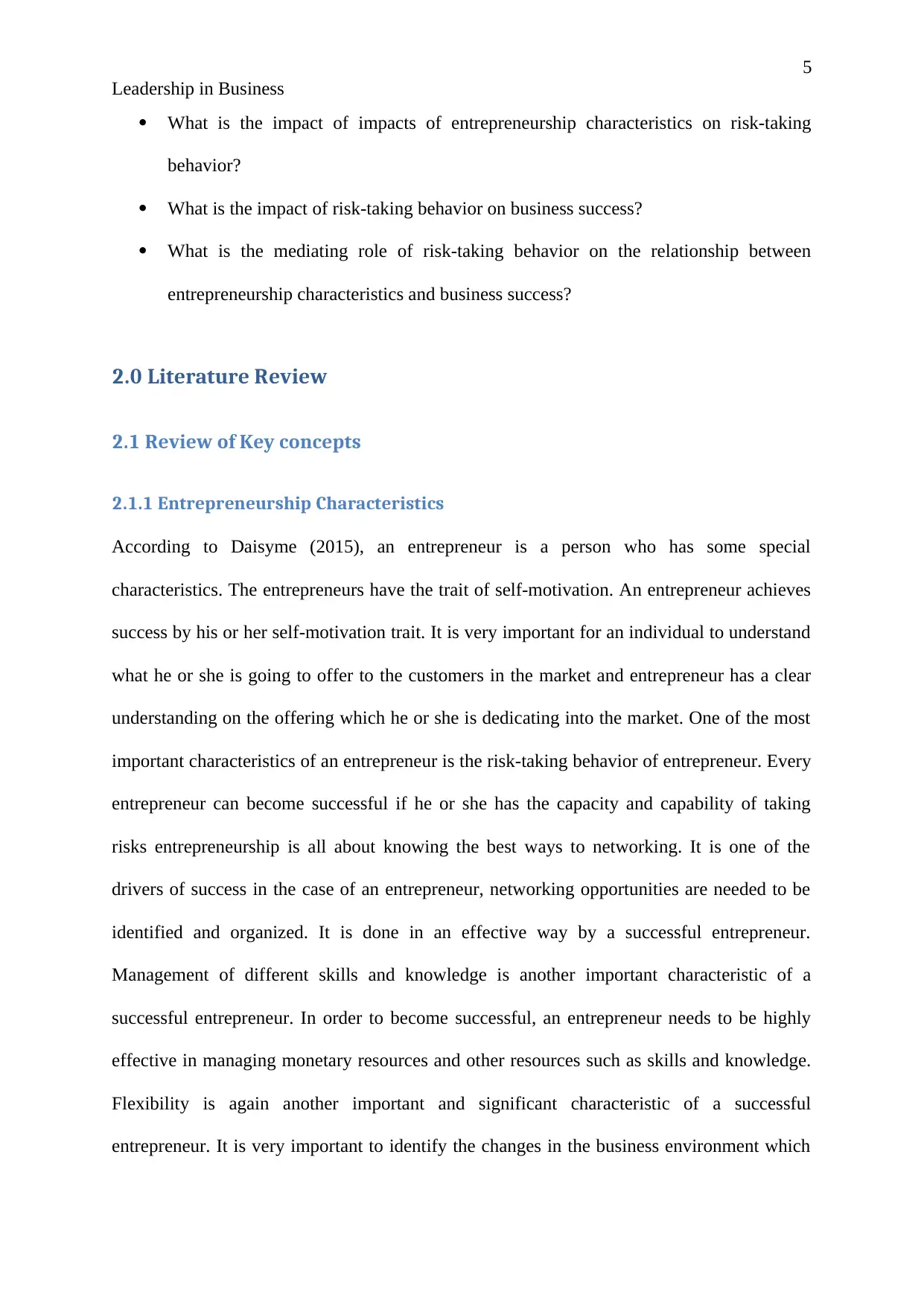
5
Leadership in Business
What is the impact of impacts of entrepreneurship characteristics on risk-taking
behavior?
What is the impact of risk-taking behavior on business success?
What is the mediating role of risk-taking behavior on the relationship between
entrepreneurship characteristics and business success?
2.0 Literature Review
2.1 Review of Key concepts
2.1.1 Entrepreneurship Characteristics
According to Daisyme (2015), an entrepreneur is a person who has some special
characteristics. The entrepreneurs have the trait of self-motivation. An entrepreneur achieves
success by his or her self-motivation trait. It is very important for an individual to understand
what he or she is going to offer to the customers in the market and entrepreneur has a clear
understanding on the offering which he or she is dedicating into the market. One of the most
important characteristics of an entrepreneur is the risk-taking behavior of entrepreneur. Every
entrepreneur can become successful if he or she has the capacity and capability of taking
risks entrepreneurship is all about knowing the best ways to networking. It is one of the
drivers of success in the case of an entrepreneur, networking opportunities are needed to be
identified and organized. It is done in an effective way by a successful entrepreneur.
Management of different skills and knowledge is another important characteristic of a
successful entrepreneur. In order to become successful, an entrepreneur needs to be highly
effective in managing monetary resources and other resources such as skills and knowledge.
Flexibility is again another important and significant characteristic of a successful
entrepreneur. It is very important to identify the changes in the business environment which
Leadership in Business
What is the impact of impacts of entrepreneurship characteristics on risk-taking
behavior?
What is the impact of risk-taking behavior on business success?
What is the mediating role of risk-taking behavior on the relationship between
entrepreneurship characteristics and business success?
2.0 Literature Review
2.1 Review of Key concepts
2.1.1 Entrepreneurship Characteristics
According to Daisyme (2015), an entrepreneur is a person who has some special
characteristics. The entrepreneurs have the trait of self-motivation. An entrepreneur achieves
success by his or her self-motivation trait. It is very important for an individual to understand
what he or she is going to offer to the customers in the market and entrepreneur has a clear
understanding on the offering which he or she is dedicating into the market. One of the most
important characteristics of an entrepreneur is the risk-taking behavior of entrepreneur. Every
entrepreneur can become successful if he or she has the capacity and capability of taking
risks entrepreneurship is all about knowing the best ways to networking. It is one of the
drivers of success in the case of an entrepreneur, networking opportunities are needed to be
identified and organized. It is done in an effective way by a successful entrepreneur.
Management of different skills and knowledge is another important characteristic of a
successful entrepreneur. In order to become successful, an entrepreneur needs to be highly
effective in managing monetary resources and other resources such as skills and knowledge.
Flexibility is again another important and significant characteristic of a successful
entrepreneur. It is very important to identify the changes in the business environment which
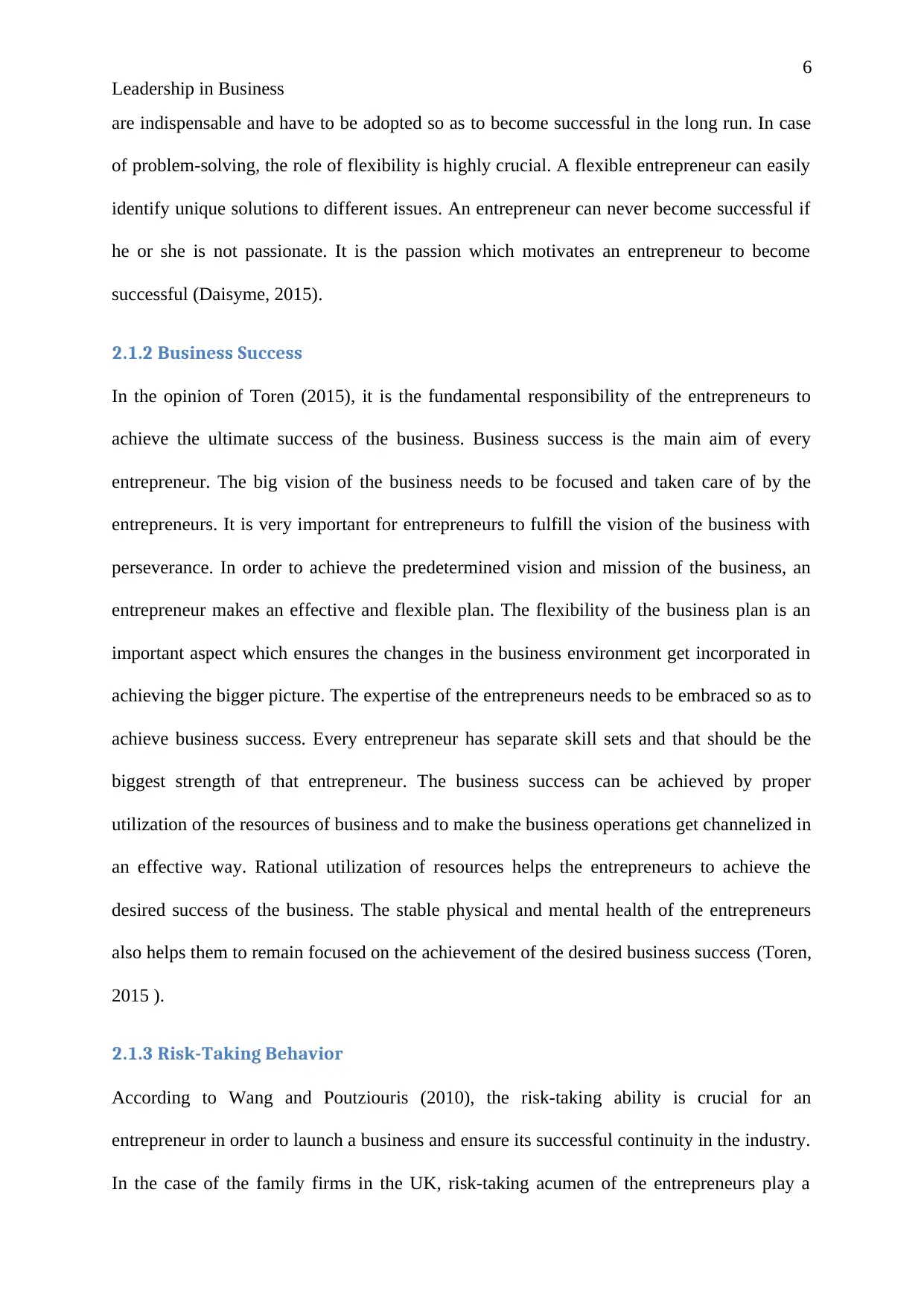
6
Leadership in Business
are indispensable and have to be adopted so as to become successful in the long run. In case
of problem-solving, the role of flexibility is highly crucial. A flexible entrepreneur can easily
identify unique solutions to different issues. An entrepreneur can never become successful if
he or she is not passionate. It is the passion which motivates an entrepreneur to become
successful (Daisyme, 2015).
2.1.2 Business Success
In the opinion of Toren (2015), it is the fundamental responsibility of the entrepreneurs to
achieve the ultimate success of the business. Business success is the main aim of every
entrepreneur. The big vision of the business needs to be focused and taken care of by the
entrepreneurs. It is very important for entrepreneurs to fulfill the vision of the business with
perseverance. In order to achieve the predetermined vision and mission of the business, an
entrepreneur makes an effective and flexible plan. The flexibility of the business plan is an
important aspect which ensures the changes in the business environment get incorporated in
achieving the bigger picture. The expertise of the entrepreneurs needs to be embraced so as to
achieve business success. Every entrepreneur has separate skill sets and that should be the
biggest strength of that entrepreneur. The business success can be achieved by proper
utilization of the resources of business and to make the business operations get channelized in
an effective way. Rational utilization of resources helps the entrepreneurs to achieve the
desired success of the business. The stable physical and mental health of the entrepreneurs
also helps them to remain focused on the achievement of the desired business success (Toren,
2015 ).
2.1.3 Risk-Taking Behavior
According to Wang and Poutziouris (2010), the risk-taking ability is crucial for an
entrepreneur in order to launch a business and ensure its successful continuity in the industry.
In the case of the family firms in the UK, risk-taking acumen of the entrepreneurs play a
Leadership in Business
are indispensable and have to be adopted so as to become successful in the long run. In case
of problem-solving, the role of flexibility is highly crucial. A flexible entrepreneur can easily
identify unique solutions to different issues. An entrepreneur can never become successful if
he or she is not passionate. It is the passion which motivates an entrepreneur to become
successful (Daisyme, 2015).
2.1.2 Business Success
In the opinion of Toren (2015), it is the fundamental responsibility of the entrepreneurs to
achieve the ultimate success of the business. Business success is the main aim of every
entrepreneur. The big vision of the business needs to be focused and taken care of by the
entrepreneurs. It is very important for entrepreneurs to fulfill the vision of the business with
perseverance. In order to achieve the predetermined vision and mission of the business, an
entrepreneur makes an effective and flexible plan. The flexibility of the business plan is an
important aspect which ensures the changes in the business environment get incorporated in
achieving the bigger picture. The expertise of the entrepreneurs needs to be embraced so as to
achieve business success. Every entrepreneur has separate skill sets and that should be the
biggest strength of that entrepreneur. The business success can be achieved by proper
utilization of the resources of business and to make the business operations get channelized in
an effective way. Rational utilization of resources helps the entrepreneurs to achieve the
desired success of the business. The stable physical and mental health of the entrepreneurs
also helps them to remain focused on the achievement of the desired business success (Toren,
2015 ).
2.1.3 Risk-Taking Behavior
According to Wang and Poutziouris (2010), the risk-taking ability is crucial for an
entrepreneur in order to launch a business and ensure its successful continuity in the industry.
In the case of the family firms in the UK, risk-taking acumen of the entrepreneurs play a
⊘ This is a preview!⊘
Do you want full access?
Subscribe today to unlock all pages.

Trusted by 1+ million students worldwide
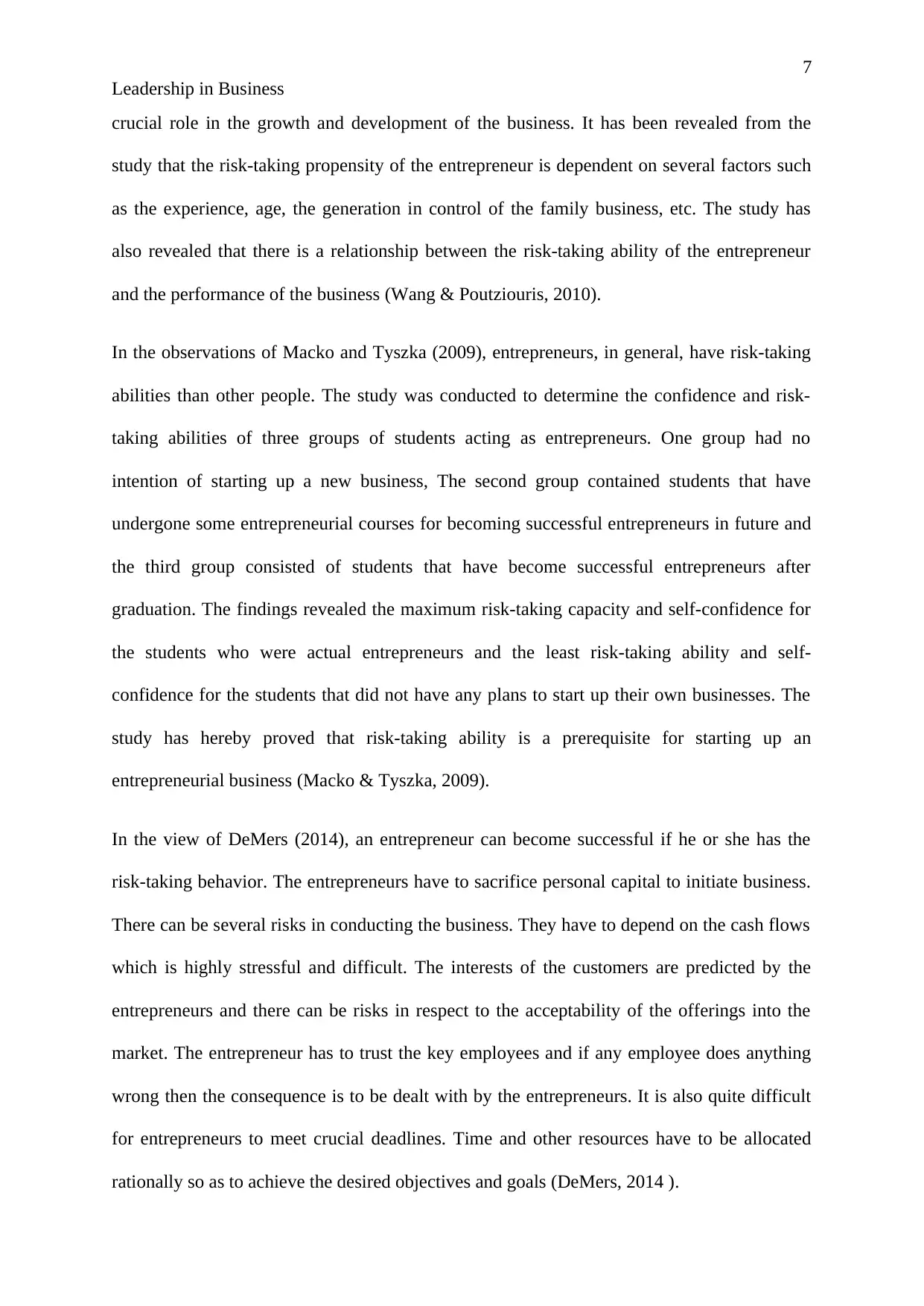
7
Leadership in Business
crucial role in the growth and development of the business. It has been revealed from the
study that the risk-taking propensity of the entrepreneur is dependent on several factors such
as the experience, age, the generation in control of the family business, etc. The study has
also revealed that there is a relationship between the risk-taking ability of the entrepreneur
and the performance of the business (Wang & Poutziouris, 2010).
In the observations of Macko and Tyszka (2009), entrepreneurs, in general, have risk-taking
abilities than other people. The study was conducted to determine the confidence and risk-
taking abilities of three groups of students acting as entrepreneurs. One group had no
intention of starting up a new business, The second group contained students that have
undergone some entrepreneurial courses for becoming successful entrepreneurs in future and
the third group consisted of students that have become successful entrepreneurs after
graduation. The findings revealed the maximum risk-taking capacity and self-confidence for
the students who were actual entrepreneurs and the least risk-taking ability and self-
confidence for the students that did not have any plans to start up their own businesses. The
study has hereby proved that risk-taking ability is a prerequisite for starting up an
entrepreneurial business (Macko & Tyszka, 2009).
In the view of DeMers (2014), an entrepreneur can become successful if he or she has the
risk-taking behavior. The entrepreneurs have to sacrifice personal capital to initiate business.
There can be several risks in conducting the business. They have to depend on the cash flows
which is highly stressful and difficult. The interests of the customers are predicted by the
entrepreneurs and there can be risks in respect to the acceptability of the offerings into the
market. The entrepreneur has to trust the key employees and if any employee does anything
wrong then the consequence is to be dealt with by the entrepreneurs. It is also quite difficult
for entrepreneurs to meet crucial deadlines. Time and other resources have to be allocated
rationally so as to achieve the desired objectives and goals (DeMers, 2014 ).
Leadership in Business
crucial role in the growth and development of the business. It has been revealed from the
study that the risk-taking propensity of the entrepreneur is dependent on several factors such
as the experience, age, the generation in control of the family business, etc. The study has
also revealed that there is a relationship between the risk-taking ability of the entrepreneur
and the performance of the business (Wang & Poutziouris, 2010).
In the observations of Macko and Tyszka (2009), entrepreneurs, in general, have risk-taking
abilities than other people. The study was conducted to determine the confidence and risk-
taking abilities of three groups of students acting as entrepreneurs. One group had no
intention of starting up a new business, The second group contained students that have
undergone some entrepreneurial courses for becoming successful entrepreneurs in future and
the third group consisted of students that have become successful entrepreneurs after
graduation. The findings revealed the maximum risk-taking capacity and self-confidence for
the students who were actual entrepreneurs and the least risk-taking ability and self-
confidence for the students that did not have any plans to start up their own businesses. The
study has hereby proved that risk-taking ability is a prerequisite for starting up an
entrepreneurial business (Macko & Tyszka, 2009).
In the view of DeMers (2014), an entrepreneur can become successful if he or she has the
risk-taking behavior. The entrepreneurs have to sacrifice personal capital to initiate business.
There can be several risks in conducting the business. They have to depend on the cash flows
which is highly stressful and difficult. The interests of the customers are predicted by the
entrepreneurs and there can be risks in respect to the acceptability of the offerings into the
market. The entrepreneur has to trust the key employees and if any employee does anything
wrong then the consequence is to be dealt with by the entrepreneurs. It is also quite difficult
for entrepreneurs to meet crucial deadlines. Time and other resources have to be allocated
rationally so as to achieve the desired objectives and goals (DeMers, 2014 ).
Paraphrase This Document
Need a fresh take? Get an instant paraphrase of this document with our AI Paraphraser
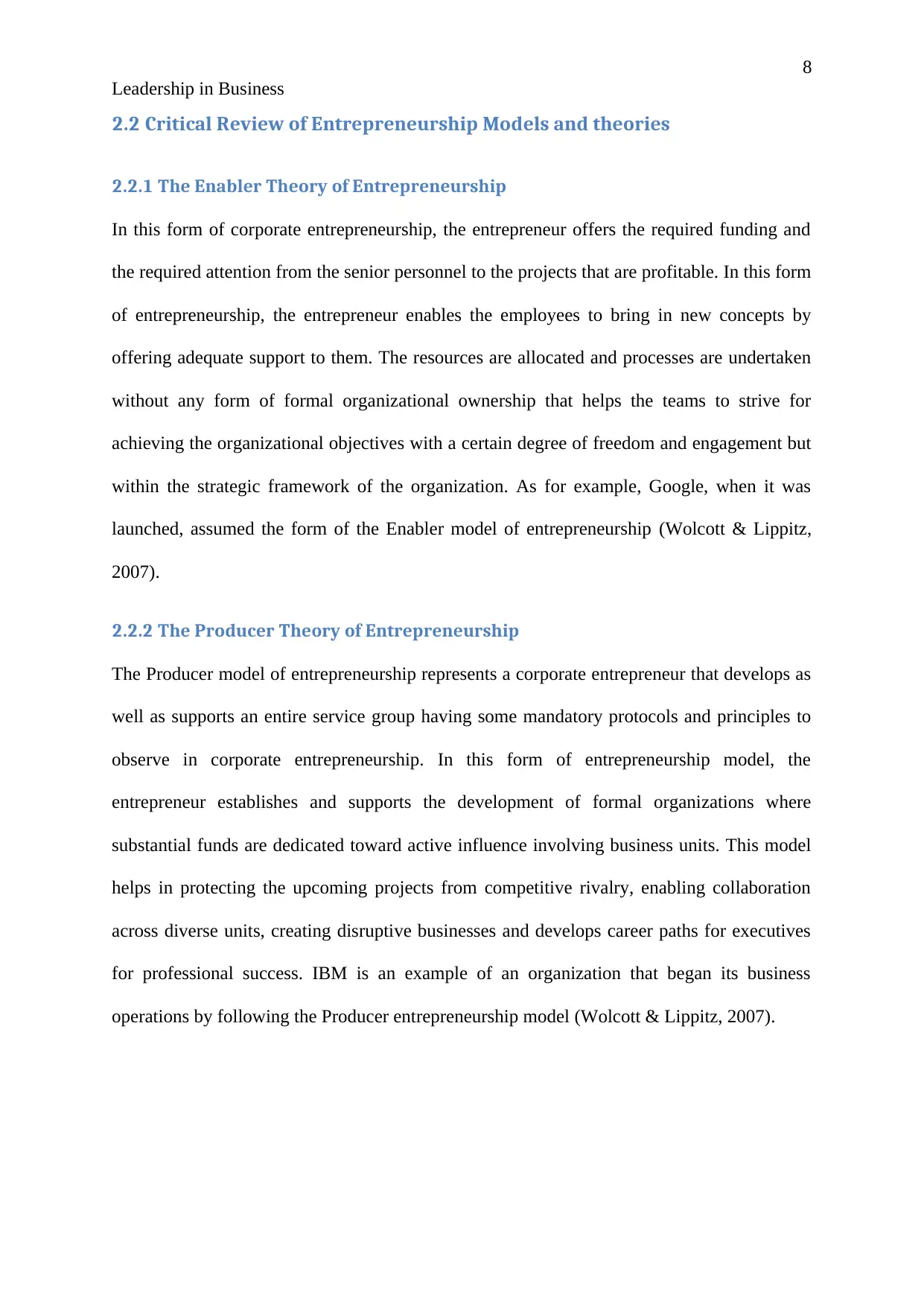
8
Leadership in Business
2.2 Critical Review of Entrepreneurship Models and theories
2.2.1 The Enabler Theory of Entrepreneurship
In this form of corporate entrepreneurship, the entrepreneur offers the required funding and
the required attention from the senior personnel to the projects that are profitable. In this form
of entrepreneurship, the entrepreneur enables the employees to bring in new concepts by
offering adequate support to them. The resources are allocated and processes are undertaken
without any form of formal organizational ownership that helps the teams to strive for
achieving the organizational objectives with a certain degree of freedom and engagement but
within the strategic framework of the organization. As for example, Google, when it was
launched, assumed the form of the Enabler model of entrepreneurship (Wolcott & Lippitz,
2007).
2.2.2 The Producer Theory of Entrepreneurship
The Producer model of entrepreneurship represents a corporate entrepreneur that develops as
well as supports an entire service group having some mandatory protocols and principles to
observe in corporate entrepreneurship. In this form of entrepreneurship model, the
entrepreneur establishes and supports the development of formal organizations where
substantial funds are dedicated toward active influence involving business units. This model
helps in protecting the upcoming projects from competitive rivalry, enabling collaboration
across diverse units, creating disruptive businesses and develops career paths for executives
for professional success. IBM is an example of an organization that began its business
operations by following the Producer entrepreneurship model (Wolcott & Lippitz, 2007).
Leadership in Business
2.2 Critical Review of Entrepreneurship Models and theories
2.2.1 The Enabler Theory of Entrepreneurship
In this form of corporate entrepreneurship, the entrepreneur offers the required funding and
the required attention from the senior personnel to the projects that are profitable. In this form
of entrepreneurship, the entrepreneur enables the employees to bring in new concepts by
offering adequate support to them. The resources are allocated and processes are undertaken
without any form of formal organizational ownership that helps the teams to strive for
achieving the organizational objectives with a certain degree of freedom and engagement but
within the strategic framework of the organization. As for example, Google, when it was
launched, assumed the form of the Enabler model of entrepreneurship (Wolcott & Lippitz,
2007).
2.2.2 The Producer Theory of Entrepreneurship
The Producer model of entrepreneurship represents a corporate entrepreneur that develops as
well as supports an entire service group having some mandatory protocols and principles to
observe in corporate entrepreneurship. In this form of entrepreneurship model, the
entrepreneur establishes and supports the development of formal organizations where
substantial funds are dedicated toward active influence involving business units. This model
helps in protecting the upcoming projects from competitive rivalry, enabling collaboration
across diverse units, creating disruptive businesses and develops career paths for executives
for professional success. IBM is an example of an organization that began its business
operations by following the Producer entrepreneurship model (Wolcott & Lippitz, 2007).
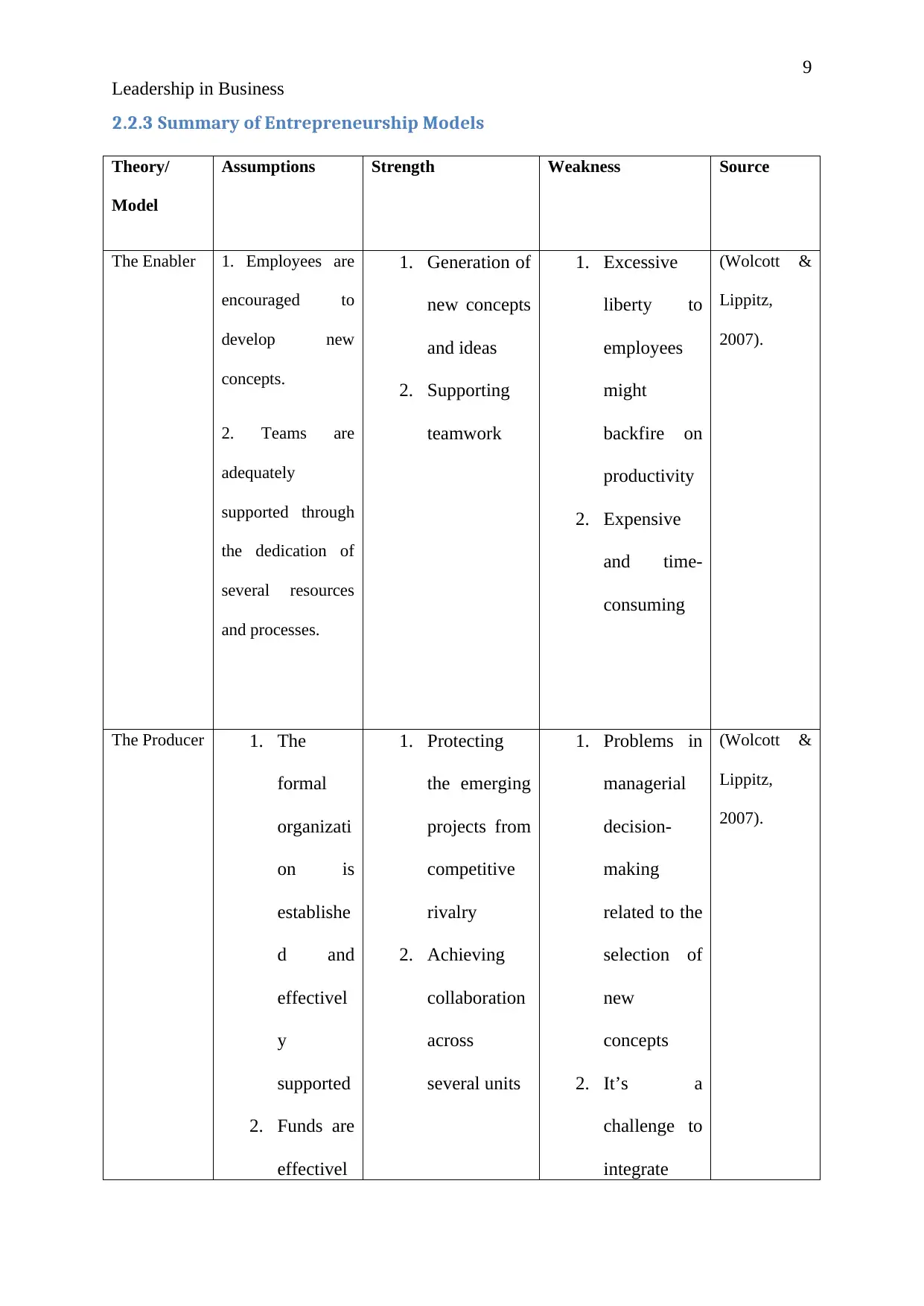
9
Leadership in Business
2.2.3 Summary of Entrepreneurship Models
Theory/
Model
Assumptions Strength Weakness Source
The Enabler 1. Employees are
encouraged to
develop new
concepts.
2. Teams are
adequately
supported through
the dedication of
several resources
and processes.
1. Generation of
new concepts
and ideas
2. Supporting
teamwork
1. Excessive
liberty to
employees
might
backfire on
productivity
2. Expensive
and time-
consuming
(Wolcott &
Lippitz,
2007).
The Producer 1. The
formal
organizati
on is
establishe
d and
effectivel
y
supported
2. Funds are
effectivel
1. Protecting
the emerging
projects from
competitive
rivalry
2. Achieving
collaboration
across
several units
1. Problems in
managerial
decision-
making
related to the
selection of
new
concepts
2. It’s a
challenge to
integrate
(Wolcott &
Lippitz,
2007).
Leadership in Business
2.2.3 Summary of Entrepreneurship Models
Theory/
Model
Assumptions Strength Weakness Source
The Enabler 1. Employees are
encouraged to
develop new
concepts.
2. Teams are
adequately
supported through
the dedication of
several resources
and processes.
1. Generation of
new concepts
and ideas
2. Supporting
teamwork
1. Excessive
liberty to
employees
might
backfire on
productivity
2. Expensive
and time-
consuming
(Wolcott &
Lippitz,
2007).
The Producer 1. The
formal
organizati
on is
establishe
d and
effectivel
y
supported
2. Funds are
effectivel
1. Protecting
the emerging
projects from
competitive
rivalry
2. Achieving
collaboration
across
several units
1. Problems in
managerial
decision-
making
related to the
selection of
new
concepts
2. It’s a
challenge to
integrate
(Wolcott &
Lippitz,
2007).
⊘ This is a preview!⊘
Do you want full access?
Subscribe today to unlock all pages.

Trusted by 1+ million students worldwide
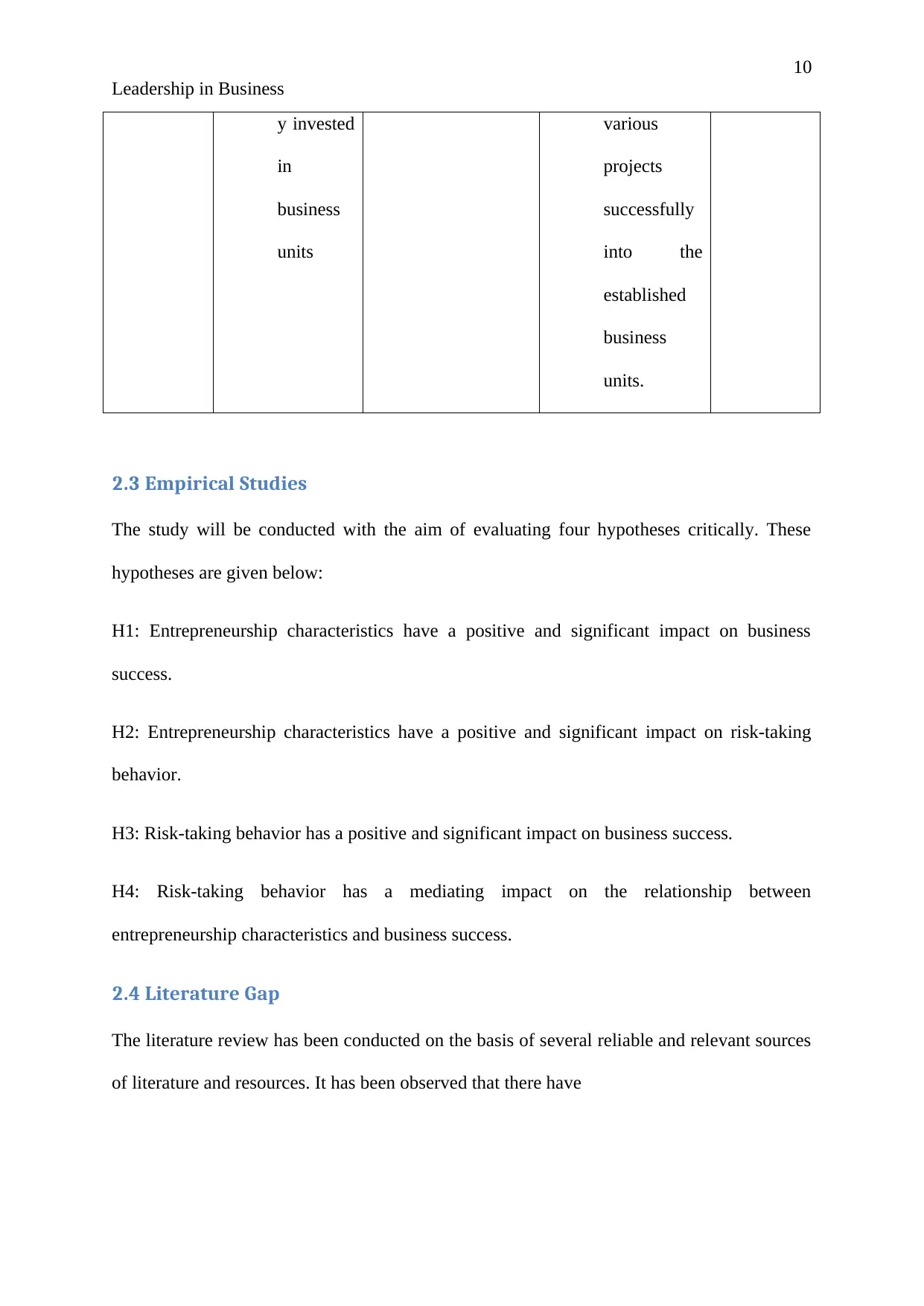
10
Leadership in Business
y invested
in
business
units
various
projects
successfully
into the
established
business
units.
2.3 Empirical Studies
The study will be conducted with the aim of evaluating four hypotheses critically. These
hypotheses are given below:
H1: Entrepreneurship characteristics have a positive and significant impact on business
success.
H2: Entrepreneurship characteristics have a positive and significant impact on risk-taking
behavior.
H3: Risk-taking behavior has a positive and significant impact on business success.
H4: Risk-taking behavior has a mediating impact on the relationship between
entrepreneurship characteristics and business success.
2.4 Literature Gap
The literature review has been conducted on the basis of several reliable and relevant sources
of literature and resources. It has been observed that there have
Leadership in Business
y invested
in
business
units
various
projects
successfully
into the
established
business
units.
2.3 Empirical Studies
The study will be conducted with the aim of evaluating four hypotheses critically. These
hypotheses are given below:
H1: Entrepreneurship characteristics have a positive and significant impact on business
success.
H2: Entrepreneurship characteristics have a positive and significant impact on risk-taking
behavior.
H3: Risk-taking behavior has a positive and significant impact on business success.
H4: Risk-taking behavior has a mediating impact on the relationship between
entrepreneurship characteristics and business success.
2.4 Literature Gap
The literature review has been conducted on the basis of several reliable and relevant sources
of literature and resources. It has been observed that there have
Paraphrase This Document
Need a fresh take? Get an instant paraphrase of this document with our AI Paraphraser
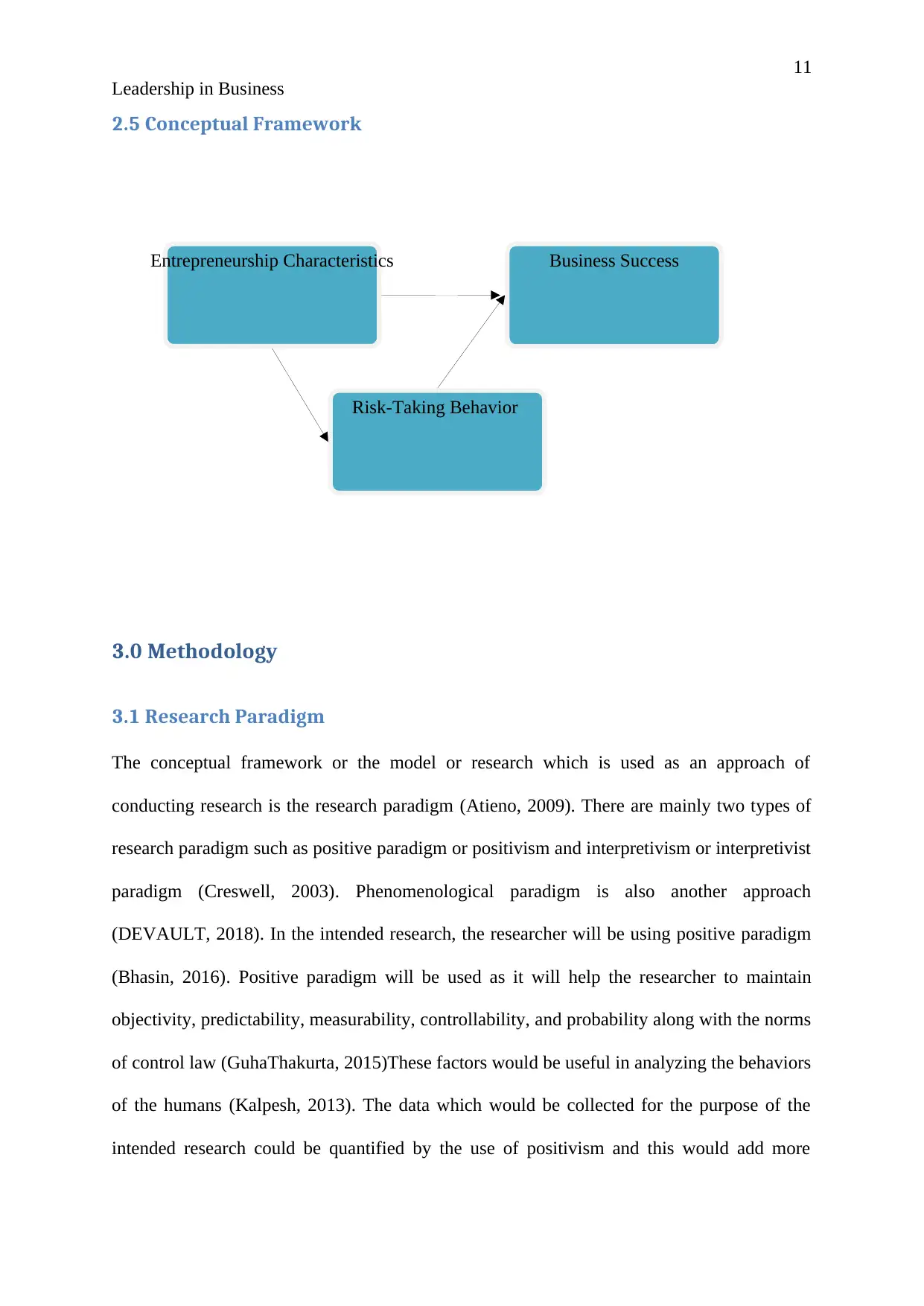
Entrepreneurship Characteristics
Risk-Taking Behavior
Business Success
11
Leadership in Business
2.5 Conceptual Framework
3.0 Methodology
3.1 Research Paradigm
The conceptual framework or the model or research which is used as an approach of
conducting research is the research paradigm (Atieno, 2009). There are mainly two types of
research paradigm such as positive paradigm or positivism and interpretivism or interpretivist
paradigm (Creswell, 2003). Phenomenological paradigm is also another approach
(DEVAULT, 2018). In the intended research, the researcher will be using positive paradigm
(Bhasin, 2016). Positive paradigm will be used as it will help the researcher to maintain
objectivity, predictability, measurability, controllability, and probability along with the norms
of control law (GuhaThakurta, 2015)These factors would be useful in analyzing the behaviors
of the humans (Kalpesh, 2013). The data which would be collected for the purpose of the
intended research could be quantified by the use of positivism and this would add more
Risk-Taking Behavior
Business Success
11
Leadership in Business
2.5 Conceptual Framework
3.0 Methodology
3.1 Research Paradigm
The conceptual framework or the model or research which is used as an approach of
conducting research is the research paradigm (Atieno, 2009). There are mainly two types of
research paradigm such as positive paradigm or positivism and interpretivism or interpretivist
paradigm (Creswell, 2003). Phenomenological paradigm is also another approach
(DEVAULT, 2018). In the intended research, the researcher will be using positive paradigm
(Bhasin, 2016). Positive paradigm will be used as it will help the researcher to maintain
objectivity, predictability, measurability, controllability, and probability along with the norms
of control law (GuhaThakurta, 2015)These factors would be useful in analyzing the behaviors
of the humans (Kalpesh, 2013). The data which would be collected for the purpose of the
intended research could be quantified by the use of positivism and this would add more
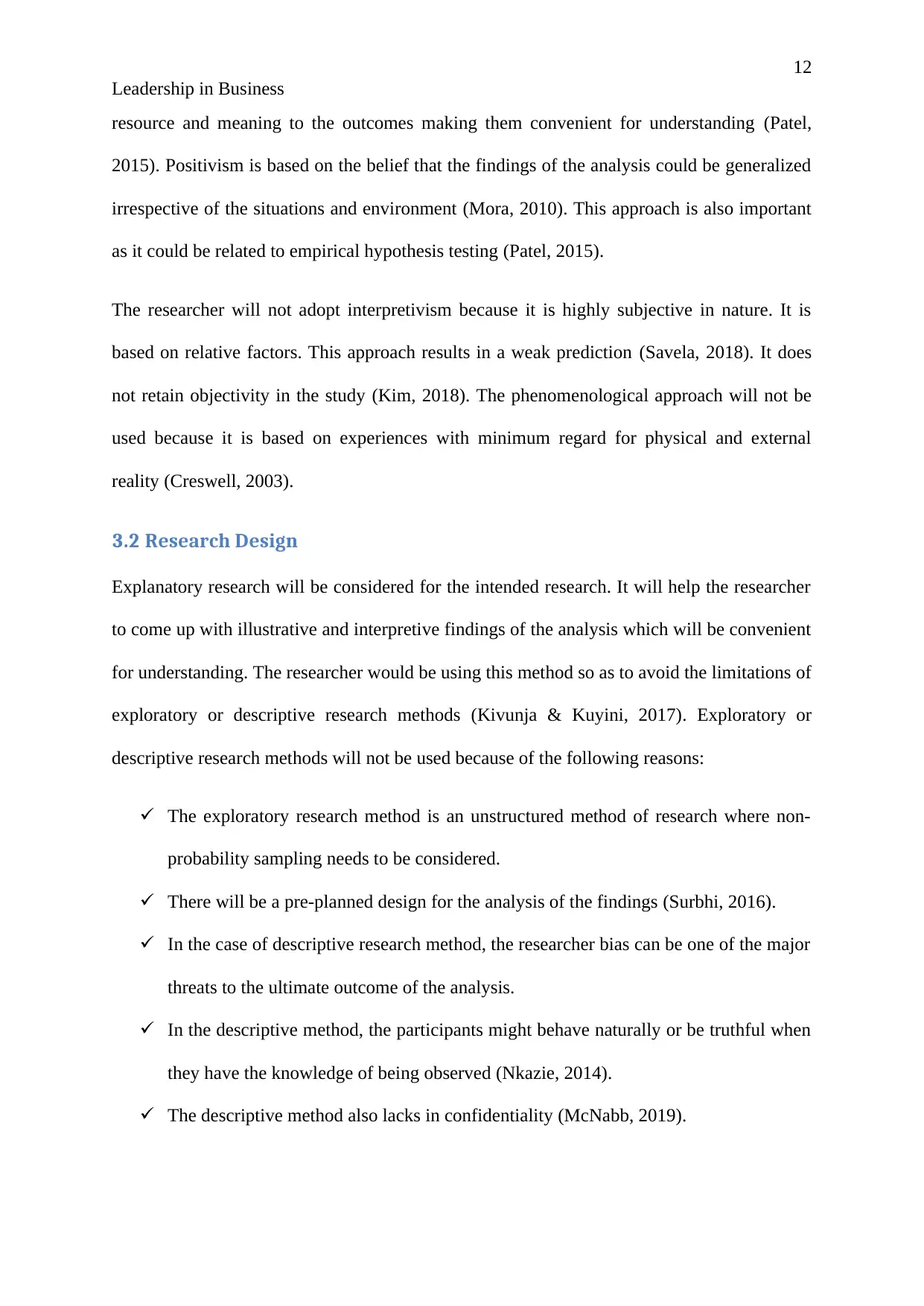
12
Leadership in Business
resource and meaning to the outcomes making them convenient for understanding (Patel,
2015). Positivism is based on the belief that the findings of the analysis could be generalized
irrespective of the situations and environment (Mora, 2010). This approach is also important
as it could be related to empirical hypothesis testing (Patel, 2015).
The researcher will not adopt interpretivism because it is highly subjective in nature. It is
based on relative factors. This approach results in a weak prediction (Savela, 2018). It does
not retain objectivity in the study (Kim, 2018). The phenomenological approach will not be
used because it is based on experiences with minimum regard for physical and external
reality (Creswell, 2003).
3.2 Research Design
Explanatory research will be considered for the intended research. It will help the researcher
to come up with illustrative and interpretive findings of the analysis which will be convenient
for understanding. The researcher would be using this method so as to avoid the limitations of
exploratory or descriptive research methods (Kivunja & Kuyini, 2017). Exploratory or
descriptive research methods will not be used because of the following reasons:
The exploratory research method is an unstructured method of research where non-
probability sampling needs to be considered.
There will be a pre-planned design for the analysis of the findings (Surbhi, 2016).
In the case of descriptive research method, the researcher bias can be one of the major
threats to the ultimate outcome of the analysis.
In the descriptive method, the participants might behave naturally or be truthful when
they have the knowledge of being observed (Nkazie, 2014).
The descriptive method also lacks in confidentiality (McNabb, 2019).
Leadership in Business
resource and meaning to the outcomes making them convenient for understanding (Patel,
2015). Positivism is based on the belief that the findings of the analysis could be generalized
irrespective of the situations and environment (Mora, 2010). This approach is also important
as it could be related to empirical hypothesis testing (Patel, 2015).
The researcher will not adopt interpretivism because it is highly subjective in nature. It is
based on relative factors. This approach results in a weak prediction (Savela, 2018). It does
not retain objectivity in the study (Kim, 2018). The phenomenological approach will not be
used because it is based on experiences with minimum regard for physical and external
reality (Creswell, 2003).
3.2 Research Design
Explanatory research will be considered for the intended research. It will help the researcher
to come up with illustrative and interpretive findings of the analysis which will be convenient
for understanding. The researcher would be using this method so as to avoid the limitations of
exploratory or descriptive research methods (Kivunja & Kuyini, 2017). Exploratory or
descriptive research methods will not be used because of the following reasons:
The exploratory research method is an unstructured method of research where non-
probability sampling needs to be considered.
There will be a pre-planned design for the analysis of the findings (Surbhi, 2016).
In the case of descriptive research method, the researcher bias can be one of the major
threats to the ultimate outcome of the analysis.
In the descriptive method, the participants might behave naturally or be truthful when
they have the knowledge of being observed (Nkazie, 2014).
The descriptive method also lacks in confidentiality (McNabb, 2019).
⊘ This is a preview!⊘
Do you want full access?
Subscribe today to unlock all pages.

Trusted by 1+ million students worldwide
1 out of 19
Related Documents
Your All-in-One AI-Powered Toolkit for Academic Success.
+13062052269
info@desklib.com
Available 24*7 on WhatsApp / Email
![[object Object]](/_next/static/media/star-bottom.7253800d.svg)
Unlock your academic potential
Copyright © 2020–2025 A2Z Services. All Rights Reserved. Developed and managed by ZUCOL.



